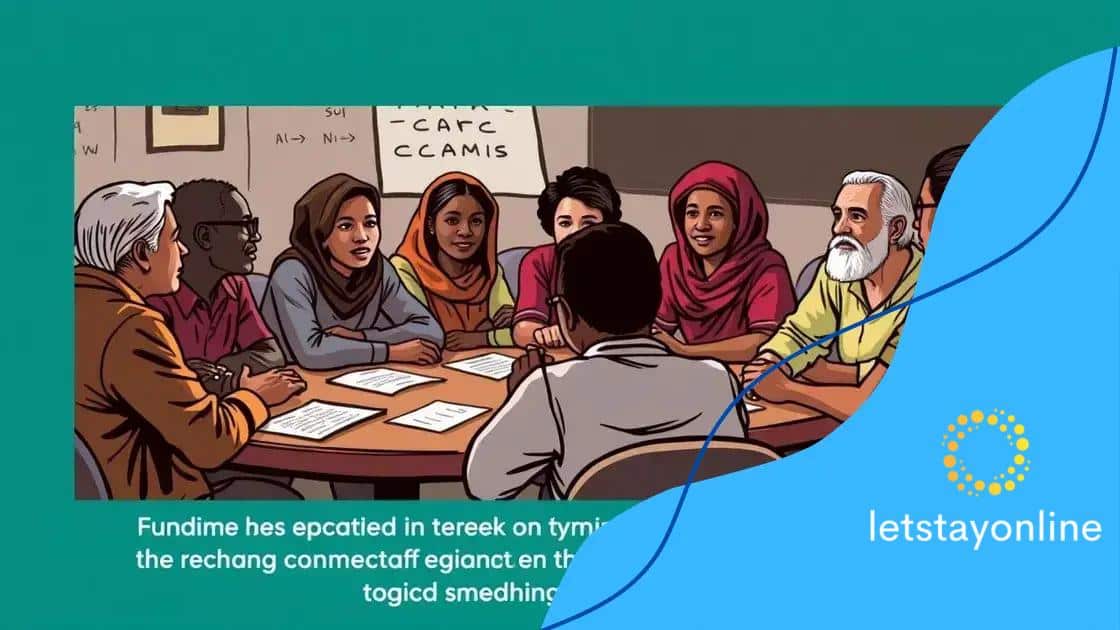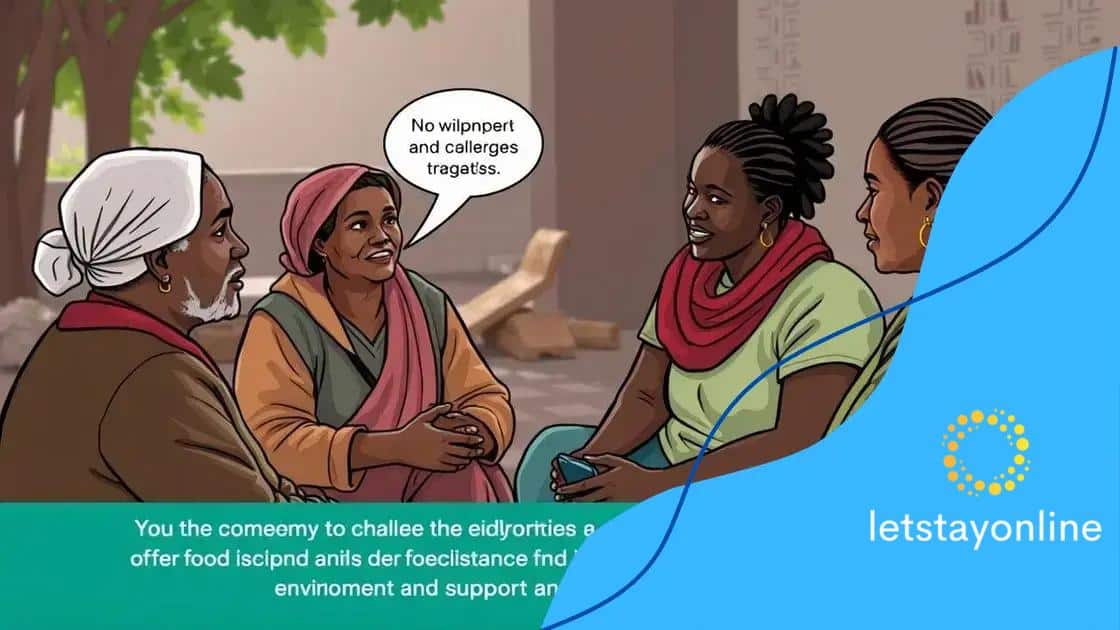Food assistance program funding shifts reshape support

Funding shifts in food assistance programs can enhance access to resources for vulnerable populations, improve community collaboration, and support healthier food choices for families facing food insecurity.
Food assistance program funding shifts are influencing how support reaches those in need. These changes can significantly impact families facing food insecurity. Have you thought about how these funding adjustments affect your community?
Understanding food assistance programs
Food assistance programs play a crucial role in helping those who face food insecurity. They provide vital support to families in need and ensure that no one goes hungry. Understanding how these programs operate is essential to grasp their impact on communities.
What are Food Assistance Programs?
Food assistance programs are designed to provide nutritional support to individuals and families who might otherwise be unable to afford sufficient food. These programs vary widely, from government-funded initiatives to local community efforts.
Main Types of Food Assistance Programs
- Supplemental Nutrition Assistance Program (SNAP)
- Women, Infants, and Children (WIC)
- Food banks and pantries
- School lunch programs
Each program serves a unique purpose and targets different populations. For instance, the SNAP program helps eligible households purchase food, while WIC focuses on nourishing pregnant women and young children.
Community involvement is also vital in understanding these programs. Local organizations often partner with government agencies to maximize outreach and ensure that those in need are aware of available resources. This collaboration enhances the effectiveness of food assistance.
The Importance of Eligibility
To benefit from food assistance programs, individuals must typically meet certain eligibility criteria. This may include income limits, household size, and residency status. Being aware of these factors can help families access the resources they require.
An important aspect is the application process, which can vary by program. Many initiatives now offer online applications, making it easier for families to apply for assistance. However, not everyone is aware of these options, leading to missed opportunities.
Education about food assistance programs can help improve participation. Community outreach is necessary to inform residents about the types of support available, how to apply, and what to expect. Many programs also provide nutrition education to help individuals make healthy food choices with the assistance they receive.
Recent funding changes and their implications

Recent funding changes are reshaping how food assistance programs operate. Understanding these shifts is vital to grasp their implications on communities and individuals.
Impact on Program Accessibility
Funding changes can either enhance or limit access to food assistance. For instance, when funding increases, more families can benefit from essential services. This can lead to improved food security in local communities.
Types of Changes in Funding
- Increased federal support for existing programs
- Redirecting funds to local organizations
- Implementation of stricter eligibility requirements
- Emerging initiatives to address specific community needs
Each of these changes carries solutions to pressing issues. For example, increasing federal support can expand outreach, while redirecting funds may lead to tailored services that meet unique community demands.
However, it’s essential to be aware of possible challenges. Stricter eligibility requirements can create barriers for some families trying to access assistance. This complicated landscape necessitates awareness and advocacy to ensure equitable access.
Community Responses to Funding Changes
Communities often adapt to recent funding shifts in various ways. Increased collaboration among local organizations can be observed, as they seek to maximize resources and share knowledge. This collaboration helps streamline services and ensures that vulnerable populations receive the support they need.
Moreover, community members often become more involved by advocating for necessary changes. Awareness campaigns can help local leaders understand the significance of these funding alterations. Such involvement enhances community resilience.
Who benefits from funding shifts?
Understanding who benefits from funding shifts in food assistance programs is essential. Many individuals and families rely on these supports to maintain their health and wellbeing.
Vulnerable Populations
The most immediate beneficiaries are vulnerable populations. These groups often experience food insecurity and rely heavily on assistance programs. They include low-income families, seniors, and individuals facing health challenges.
Benefits for Low-Income Families
- Access to nutritious food
- Improved overall health
- Reduced stress related to food costs
- Support for children’s education and development
For low-income families, funding shifts can lead to enhanced access to nutritious food, which is crucial for growth and development, especially for children. By alleviating some food-related financial burdens, families can focus on other important aspects of life.
The Role of Community Organizations
Community organizations also benefit from funding changes. These groups often play a pivotal role in distributing food assistance and may receive additional resources to enhance their services. When funding is redirected to local organizations, they can tailor their approaches to meet specific community needs more effectively.
These organizations offer a range of services, including food distribution, nutrition education, and support programs, all of which contribute to community resilience. Improved funding enables them to reach more people and provide additional resources.
Long-term Advantages for Society
In the long run, funding shifts can benefit society as a whole. When individuals and families have stable access to food, it can lead to better health outcomes and lower healthcare costs. This creates a healthier population and strengthens communities.
Additionally, supporting food assistance programs may foster economic growth. When families are not struggling to meet their basic needs, they can contribute more effectively to the local economy.
Challenges faced by communities

Communities face several challenges when dealing with changes in food assistance program funding. These hurdles can affect accessibility and overall effectiveness of the support provided.
Accessing Assistance
One of the primary challenges is accessing assistance. Many families may not be aware of the programs available to them, especially when changes occur. Miscommunication or lack of information can result in eligible families missing out on crucial support.
Stigma and Participation
- Feeling ashamed of needing help
- Concerns about judgment from others
- Fear of being labeled
- Limited outreach efforts
Stigma plays a significant role in hampering participation in food assistance programs. Many individuals feel ashamed to seek help, which keeps them from accessing necessary resources. Community outreach and education are critical in changing perceptions and encouraging participation.
Resource Limitations
Communities often have limited resources to implement food assistance programs effectively. This can lead to inadequate food supplies and a lack of volunteers. Without sufficient support, it’s challenging to meet the needs of all individuals relying on these services. When funding is inconsistent, it can strain local organizations that typically provide assistance.
In addition, organizations may struggle to provide nutritional education alongside food distribution. Education about healthy eating is essential for maximizing the benefits of the assistance, but limited capacity can make this difficult.
Economic Fluctuations
The economy significantly influences food assistance programs. Economic downturns often see an increase in demand for services. As more families face financial struggles, the available resources can become stretched thin.
On the other hand, when the economy improves, funding for food assistance programs might be reduced, which can lead to diminished services. This unpredictable cycle leaves communities vulnerable and in need of consistent support.
Future outlook for food assistance programs
The future outlook for food assistance programs is critical to understanding how communities will address food insecurity.
Trends in Funding
As awareness of food insecurity grows, funding for these programs is likely to evolve. Increasingly, governments and organizations are recognizing the need for sustainable support. This recognition could lead to more stable financing and innovative funding sources.
Emerging Programs and Initiatives
- Community-based support networks
- Nutrition education programs
- Partnerships with local farms
- Technology use for resource distribution
New programs may emerge that focus on community-based solutions. Collaborations with local farmers and businesses can promote fresh and healthy food access. Technology might also play a role, streamlining the application processes and improving resource distribution.
Policy Changes
Future policy changes can significantly impact food assistance. Advocacy for fair policies can lead to more inclusive programs. By considering the unique needs of communities, future policies may prioritize those who are most vulnerable. This is crucial for addressing systemic inequalities that lead to food insecurity.
Engagement from community members will play an essential role in shaping these policies. Ensuring that voices from diverse backgrounds are heard can improve program effectiveness and reach.
The Role of Education
Education will continue to be a vital aspect of food assistance. Programs that educate families on nutrition may see increased funding and support. Teaching individuals how to cook healthy meals and budget for food can empower them to make better choices.
As education improves, communities can work toward long-term solutions for food security. This shift can result in healthier populations and lower healthcare costs.
The future of food assistance programs holds great promise as communities adapt to ongoing challenges. With a focus on innovative solutions, increased funding, and active community involvement, there is potential for significant positive change. As we move forward, recognizing the needs of vulnerable populations and advocating for fair policies will be crucial. Education also plays a key role in empowering families to make healthier choices. Together, these efforts can lead to a healthier, more secure future for all.
FAQ – Frequently Asked Questions about Food Assistance Programs
What are food assistance programs?
Food assistance programs provide support to individuals and families facing food insecurity, helping them access nutritious food.
Who benefits from food assistance program funding shifts?
Funding shifts can benefit vulnerable populations, including low-income families, seniors, and individuals with health challenges.
What challenges do communities face with food assistance?
Communities may face challenges such as limited access to information, stigma, and resource shortages, which can affect program effectiveness.
How can communities improve food assistance programs?
Communities can enhance food assistance programs through increased advocacy, education, and collaboration among local organizations.






